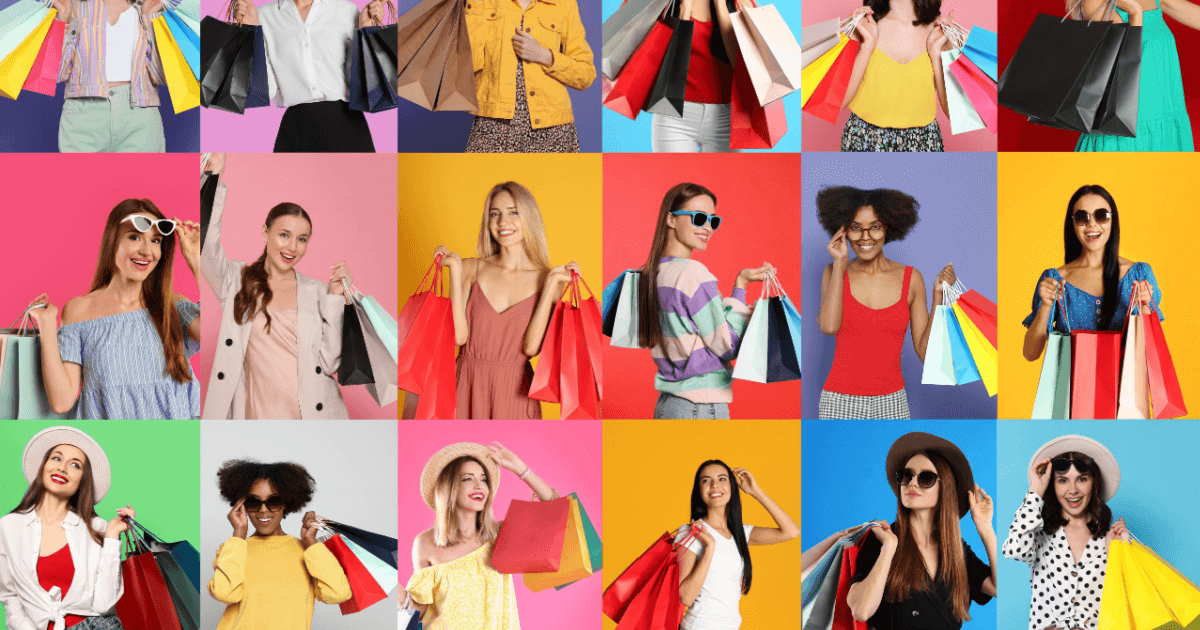January 4, 2024
No two customers are alike. Each type of shopper is as diverse as the brands they like and products they buy. But that doesn’t mean your strategy to sell to each of those groups has to feel scattered.
Understanding the six core types of shopper — and the best strategies to reach them — will help you better connect to your customers, meet their needs, and drive more ROI for your business.
What are the six types of shopper?
Most buyers will fall into one (or two or three) of the following buckets:
- Impulse buyer: makes quick, spontaneous purchases
- Researcher: looks around for the best deal before buying
- Casual shopper: browses without a specific purpose or need
- Needs-based shopper: shops only when they need a specific item or service
- Brand loyalist: prioritizes familiarity and usually buys from the same trusted brands
- Social shopper: relies on input and recommendations from friends, family, or social media
It’s important to understand each of these types of shoppers — and target them with customized content and strategies.
Impulse buyers
There’s no shopping lists for this crew. Impulse purchasers are spontaneous. They don’t obsess over researching the best products or brands. They don’t spend hours comparing prices. Instead, they’re all about instant gratification. They have a problem. You have a solution. Let’s make this happen!
Perhaps the most important thing to know about this type of shopper is that they’re driven by emotions. These emotions can be positive: They’re excited to try a new hot sauce or they can’t wait to buy a new couch.
Impulse buyers might also be motivated to address negative emotions. Maybe they feel embarrassed by a skin condition and want to find a product that will ease their symptoms and make them feel more confident. Or they might feel like their current phone or tablet isn’t as cool as their best friend’s. An impulse shopper will want to address this feeling of inadequacy by buying a new device — quickly.
Finally, impulse buyers may be driven by emotions that have nothing to do with the product they‘re buying. Instead, they’re simply trying to address feelings of boredom, job stress, anxiety, etc. Shopping makes them feel better.
How to sell to impulse shoppers
The best way to appeal to this type of shopper? Make it easy for them to see your products as the solution to their emotional needs.
If they’re shopping in-store, use stand-out imagery and signage to highlight your product. Place the items you’re trying to promote in areas that get a lot of traffic, like the entrance. The checkout counter is also a prime place to reach these spontaneous shoppers.
You can also embrace the power of user-generated content (UGC) — social imagery, product reviews, and videos created by customers, not your brand — to reach impulse buyers because 76% of impulse shoppers say reviews and other forms of UGC affect their purchasing decisions.
In-store, that can mean signage that promotes user ratings. Online, you can have a field day with your UGC — especially customer photos:
- 65% of impulse buyers say photos of products taken by other shoppers affect their purchasing decisions
- 60% expect to see shopper photos on product pages
When Hobbycraft, the UK’s largest arts and crafts retailer, featured visual UGC on their site, they saw a 219% increase in conversions and a 24% boost in average order value.
Finally, make it easy for impulse buyers to see related items or add-ons throughout the e-commerce experience. If you have additional solutions that can address their needs — or related products that make the item they’re purchasing more powerful — by all means, let them know!
Researchers
Researchers are the “Type A” of shoppers. Before making a purchase, they launch a thorough investigation. Which companies sell what they need and at what the price point? Are customers generally happy with their purchases? How do the products look in the real world?
A researcher will have all the answers. They might even have a spreadsheet full of answers. But what they don’t have is a desire to make a willy-nilly purchase. They take their time, weigh their options, analyze all the available information, and (eventually) make an informed decision.
How to sell to researchers
One way to quickly turn away this type of shopper is to have an outdated website or social channels. When buyers are neck-deep in research, there’s nothing worse than finding a lack of usable info on a brand’s website.
Maybe you’re running online ads for a new couch — but there’s no photos of the piece on your website or social. Or maybe all the reviews on your site are from 2017. This could be a big problem for researchers. Make sure to regularly update content so researchers get a full, current view of your brand and products. This includes up-to-date UGC.
- 32% of this type of shopper need to see three to five photos and videos on a product page to confidently make a purchase
- 51% of researchers likely won’t buy a product unless they see shopper content like reviews, photos, videos, Q&A, or social posts
When cycling gear company Le Col promoted authentic customer reviews and images on its website and product pages, visitors were 5x more likely to convert.
Remember: Researchers are on the hunt for the best deal. So offer one that will catch their eye! 89% of shoppers will spend five minutes or more reading reviews, images, and social content before making a purchase. You need to make research shoppers find your deals regardless of the channel they use. And it can be really simple to achieve.
For example, to win over researcher shoppers on social, Kelly Reis, Product Development and Merchandising Manager at Linon Home Decor, makes sure that, “we provide our Instagram followers with opportunities to shop our products on sale at select retailers and guide them towards the best deals for them.” They also include sale-specific information in captions to drive shoppers directly to their Like2Buy.
Casual buyers
These are the shoppers who don’t necessarily need a specific item. They’re just browsing! Maybe they already have a solid winter coat. But they saw your puffer jackets are on sale and are clicking through out of curiosity.
This casual behavior can be good news and bad news.
On one hand, browsers probably spend a lot of time shopping — which means there’s an opportunity to turn them into dedicated customers. Since they’re already on your website, a great user experience could inspire them to keep coming back.
On the other hand, casual buyers like to keep their options open. They’re less likely to make a quick purchase and are even okay with not buying anything at all. They abandon their cart more frequently than other types of shoppers. With no compelling purpose behind their shopping and no pressing problem to solve, these customers need a little extra motivation to click “buy now.”
How to sell to casual shoppers
Human beings — especially casual shoppers — are drawn to stories. So lean on the story behind your products. When a casual customer can connect to the “why” behind an item, that product becomes more than a thing to buy. It sparks an emotion or helps the customer relate to a brand.
To appeal to this type of shopper, you’ll also want your overall shopping experience to feel welcoming and comforting.
- DO: Have clear, upfront offers to get their attention
- DON’T: Rely on aggressive tactics, like multiple pop-up windows or frantic “last chance” messaging. In-store, these shoppers will also be turned off by high-pressure salespeople
Casual customers don’t want to be pushed into buying something. They want a stress-free, low-stakes shopping experience.
Needs-based buyers
When it comes to the different types of shoppers, needs-based buyers are the ones moving with purpose down the aisle (or through your product pages). They know what they’re looking for. And they want to find it quickly and conveniently — with no distractions.
They don’t want to wade through “similar products” or recommended add-ons. They just want to click or swipe and get on with their day.
How to sell to needs-based shoppers
Make sure you have the products this buyer needs: That’s priority #1. Beyond that, think about how to provide more value and education throughout the buying journey. 64% of needs-based buyers use shopper content to evaluate whether the product is worth the investment
This is your chance to provide webinars, articles, and more that showcase the benefits of your products. What content can you offer to reassure this type of buyer that your product is exactly what they’re looking for?
Gift guides are another way to reach needs-based shoppers. Let’s say they’re shopping for an espresso machine on your site. Why not offer a handy buyers’ guide that outlines the features and benefits of different models? This gives needs-based customers all of the info they need to confidently make a decision.
If these purpose-driven shoppers have questions, the last thing they want is to dig through your website to find the answer. Having FAQs on your website is a good way to close that gap. Chatbots can also help answer basic questions. For more involved customer service, make sure the contact info for your human-led team is easy to find on your website.
Brand loyalists
For brand loyalists, it’s all about trust. They repeatedly buy from brands they know, can identify with, and can rely on.
This type of shopper values consistency and is less likely to swap allegiance to a new brand based on a random sale. And that’s good news for brands and retailers: Once brand loyalists trust you, they’ll often pay a premium for your products.
Apple enthusiasts may pay a little extra to have a Mac computer, an iPad, an Apple watch, and the latest iPhone. But you’ll have a tough time persuading them to switch to a Samsung phone or PC. Nike fans could probably buy a different brand of sneakers — but instead they’ll wait in line for hours to pick up the latest Jordans. There’ are’s plenty of polo shirts out there in the world. But Lacoste brand enthusiasts want the ones with the iconic alligator sewn onto the chest.
In these instances, brand loyalty beats the cheapest price, most convenient buying experience, or other consumer preferences.
How to sell to brand loyalists
Even among these types of shoppers, nothing is set in stone. 54% of loyalists are still open to trying a different company. The secret to keep them coming back is to elevate their experiences with your brand:
Loyalty programs. For example, try a reward system where customers earn points with each purchase. Then they can redeem those toward discounts, bonus services, or even free products.
Ambassador or referral program. Reward happy customers for sending new shoppers your way. For instance, if a customer refers three buyers to your brand, they get a free tote bag or a discount on a future purchase.
Customized user experience. Wherever you can, show customers they’re not just a number. Maybe give them access to a unique login portal where they can see their points balance or special offers that month. Or give specific product recommendations based on their previous purchases.
Shoppertainment opportunities. Shoppertainment is an emerging method for boosting shopper engagement and creating loyalty. If there’s a way to promote your products through a fun experience, take advantage. For example, customers can use virtual reality to visualize new furniture in their living room or to try on clothes before purchasing. You can also incorporate gaming elements into the shopping experience.
However you can show this type of shopper that they’re special — and that your brand values them — will help you remain top of mind the next time they want to make a purchase.
Social buyers
These social butterflies make purchasing decisions largely based on recommendations. What do their friends like? What do online reviews say? Is there social media buzz around a product?
This type of shopper wants social approval and likes to stay trendy. They value feedback from others, both in person and online. Shopping is a social activity to them, and their friends’ input in real time can help boost a product in their eyes.
UGC also makes a big mark for this segment of shoppers. If a particular kitchen appliance or dog-grooming tool keeps getting recommended by their social media algorithm or influencers they follow, they’ll pay attention.
How to sell to social shoppers
You’ll want to keep your brand’s social media pages up to date. Better yet, make sure these are engaging. Don’t just post and click away from the page. Interact with your online community!
Don’t forget to feature all of the awesome UGC you’ve collected, including stories, testimonials, and photos or videos, on your social media profiles. Because for many shoppers, social media is the new search:
- 64% of social shoppers use social media as a product discovery tool
- 62% use social media to research a brand or item
- 56% of social buyers follow their favorite brands on social media to discover more products
- 42% of social shoppers prefer to shop directly on social media
Considering how important social media has become to most customers’ shopping experiences, your social media profiles are gold mines of opportunity. Take advantage of this space by beefing them up with shoppable UGC. Incorporating shoppable UGC onto your social channels — and everywhere social reaches — inspires purchases which leads to tangible results, as these three social commerce case studies demonstrate:
- UK bed specialist Dreams saw a 200% lift in conversions and a 62% increase in average order value
- MAM, a brand selling premium baby products, doubled traffic and conversion rates — and even saw a 258% increase in time on site
- Bemz, which creates made-to-order furniture covers, increased its new revenue by $1.65 million
And don’t forget to include UGC on your homepage, landing pages, and product detail pages. Even if someone doesn’t go to your social media profiles, they should still be able to easily find your customers’ reviews, photos, or testimonials wherever they shop.
Reach every type of shopper by optimizing your customer experience
With so many distinct groups of shoppers — each with their own desires and behaviors — it can be overwhelming to try to reach them all. But given that world consumer spending in 2021 was $53,100 billion, it’s well worth optimizing your shopping experience to appeal to all six types of shopper:
- Prioritize UGC. For most consumers, the top two factors influencing a purchase decision are customer ratings and reviews and UGC (especially photos and videos) from real customers
- Update your website and social profiles. At least 39% of every buyer type discovers new products or services on social media. When your profiles contain accurate, relevant, and authentic information, you’ll turn visitors to your social media pages into customers
- Customize where possible: For example, you could target casual buyers with an abandoned cart email sequence. Enlist influencers or content creators to meet social shoppers where they already are. Or start up a rewards program for brand loyalists
To connect with more prospective buyers, retain current customers, and ensure higher ROI, it’s important to understand the distinct types of shoppers. With better insights into each segment, you can craft more focused marketing strategies — and drive more consistent sales.
Learn more about current shopper behaviors and preferences in the Shopper Experience Index — a global survey of 7,000 consumers and 465 brands and retailers.








